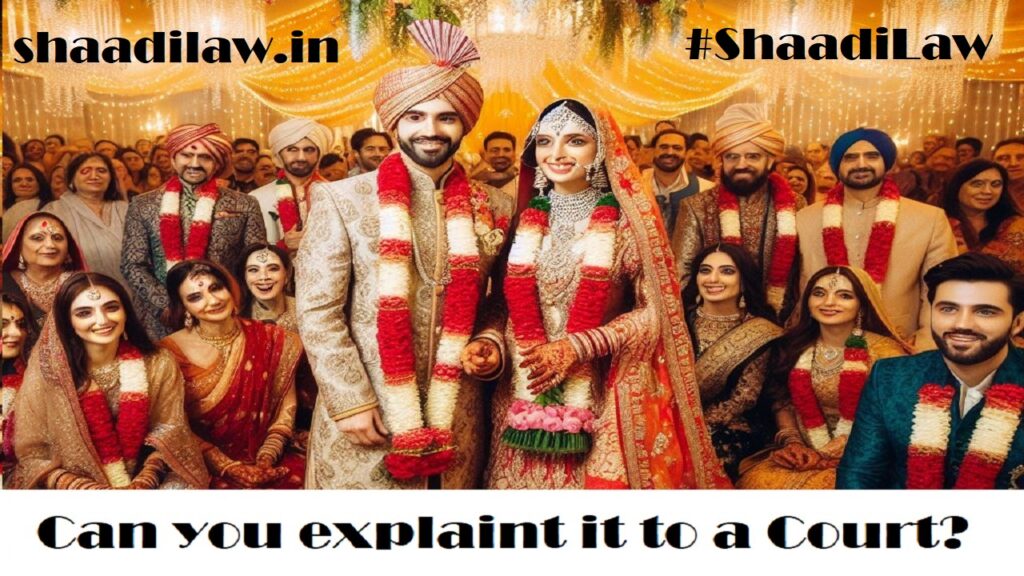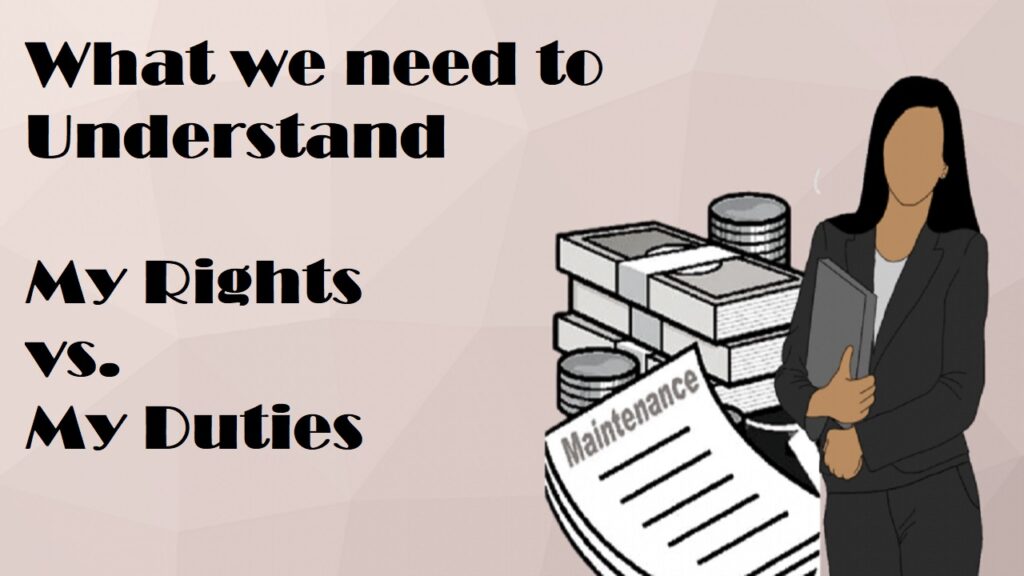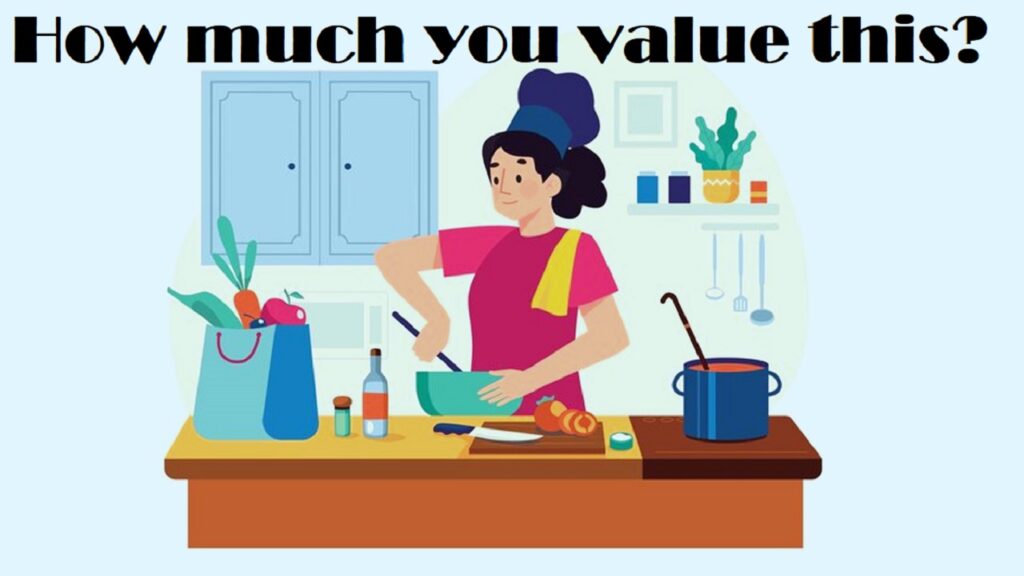Do we need to understand this?
A couple made in heaven is joined by marriage. This was the majority’s answer I got when I asked a few people if they know what is marriage. But can you tell this to a Court in response to a Court asking you “What is Marriage”?
Unless you can explain a topic to others, handle their counter-questions, and provide answers with reliable sources, you don’t know what the topic is and you only believe you know it.
Buy why do we need to understand this?
Individual perspectives do not form or shape the world, history, literature, laws, courts, and administration. Majority opinions influence creation of laws and opinions.
If you bring your own mindset to court and remain inflexible, you won’t align with the Court. This may lead to losing your case. causing you to have further frustration with the law, the system, courts, and lawyers. However, everything was due to your not understanding the basic concept of the topic you were dealing with. And you were debating experts.
In matrimonial cases, everything centers on one key topic i.e. “MARRIAGE”. It is only the concept of Marriage that will be considered while forming Laws, moral duties, ethics etc.
When presenting your case to the court, it’s crucial to communicate that you understand marriage objectively. Ensure that you address the broader aspects of marriage, not just those that favor your version or side of the case.
I do not dispute the concerns about bias in matrimonial cases within the legal system. But it’s equally important to recognize that the responsibility isn’t solely on courts, laws, lawyers, and systems; we must also take accountability.
Can men honestly deny that motives, agendas and personal benefits drive our actions, rather than behaving genuinely for the greater good of society and justice? It’s not uncommon to witness men in legal battles striving to reduce settlement amounts. Majority instances expose a culture where men compromise in false cases against them when they receive a digestible settlement offer from the other side or Court.
In the process of this case fighting, you may continually believe that you’re fighting for the right cause. However, if you pause and ask your soul, you might realize that you’re not truly championing a cause. Once the dispute concludes, you will not revisit or fix what you once thought was wrong. That’s a personal fight, not a cause.
What is Marriage?
As a lawyer, my initial instinct is to begin guiding you through a legal point of view before delving into speculations. As such I would like to refer you to a judgment from the Hon’ble High Court of Calcutta on 20th of March, 1901, in a case titled “Tekait Mon Mohini Jemadai vs. Basanta Kumar Singh“:
16. This brings us to the consideration of the question what is the Hindu Law upon this subject. It may be premised that though marriage under the Hindu Law is a contract, it is also a sacrament, it is more religious than secular in character; the union is indissoluble, for it is a “union of flesh with flesh, bone with bone.”
During the husband’s lifetime, he is to be regarded by the wife as a god and the wife is declared to be half the body of her husband, equally sharing the fruit of pure and impure acts, and no sacrifice or religious rite is allowed to her apart from the husband’s.
Hence it is that after the husband’s death, the widow is regarded as the surviving half of his body: the union is a sacred tie and subsists even after the death of the husband. See Manu, Ch. II, v. 67; Ch. Ill, v. 43; Ch. V, vv. 154, 155, 156, 157, 158, 160, 165; Ch. IX. v. 29; Dayabhaga Ch. IV, v. 14; Ch. XI, Section 1, v. 2; and Hindu Law on Marriage by Dr. Banerjee, p. 131.
My thoughts on the judgment
A beautifully laid out, well reasoned, well balanced view on marriage, well before the present law came into existence. It referred to the essence of marriage as it traditionally & spiritually stood.
Despite the evolution of the concept over time, this interpretation remains relevant, if one seeks to understand the true definition of marriage. Distinct from its present understanding from legal point of view.
It is important to acknowledge that the origin of marriage does not necessarily align with the concept of a sacrament. We have always overlooked the Origins of Marriage, as a concept, from the discussion surrounding the true nature of marriage. Focusing primarily on religious and faith-based perspectives that label it as a sacrament. However, a comprehensive understanding of marriage requires a deeper exploration of its historical and cultural roots, going beyond religious interpretations. By doing so, we can gain a more nuanced perspective on what marriage truly represents and how it has evolved throughout human history.
Origin of Marriage
Indeed, marriage existed before laws and authorities regulated society. It is a social institution that has existed across cultures and civilizations throughout history. Religisous texts are the earliest forms of compilations regarding moral and ethical duties, often providing guidelines for marriages. However, during those times, the enforcement of marriage rules and regulations did not involve legal penalties in the earthly realm. Instead, the emphasis was often on post-life consequences or supernatural beliefs as a means of safeguarding the sanctity of marriage. This spiritual or moral framework served as a form of social control and encouraged adherence to the norms and expectations associated with marriage.
What religions said about marriage?
If we were to treat marriage as purely a sacrament governed by religious preachings, women’s status will be reduced to a mere helper in a man’s life. Is it proper to apply in a society ruled by law?
If not religions, where is the concept of marriage?
Surprisingly, the Bible and Quran did not invent the concept of marriage; they merely applied it to their followers based on their own interpretations. Marriage existed long before these books, and even Prophet Mohammad (PBUH) himself got married prior to receiving enlightenment. The true origin of this concept is rooted in human history and predates both the above mentioned views.
Fortunately, the Mahabharata (taken historically and not religiously) discusses the “Origin of Marriage.” In Sambhava Parva, Chapter 122, Vaisampayana narrates the concept of marriage, portraying it in a very realistic need of the time. He said:
I shall now tell thee about the practices of old indicated by illustrious Rishis, fully acquainted with every rule of morality. O thou of handsome face and sweet smiles, women formerly were not immured within houses and dependent on husbands and other relatives.
They used to go about freely, enjoying themselves as best as they liked. O thou of excellent qualities, they did not then adhere to their husbands faithfully, and yet, O handsome one, they were not regarded sinful, for that was the sanctioned usage of the times.
That very usage is followed to this day by birds and beasts without any (exhibition of) jealousy. That practice, sanctioned by precedent, is applauded by great Rishis. O thou of taper thighs, the practice is yet regarded with respect amongst the Northern Kurus. Indeed, that usage, so lenient to women, hath the sanction of antiquity.
The present practice, however (of women’s being confined to one husband for life) hath been established but lately. I shall tell thee in detail who established it and why.
“It hath been heard by us that there was a great Rishi of the name of Uddalaka, who had a son named Swetaketu who also was an ascetic of merit.
O thou of eyes like lotus-petals, the present virtuous practice hath been established by that Swetaketu from anger. Hear thou the reason. One day, in the presence of Swetaketu’s father a Brahmana came and catching Swetaketu’s mother by the hand, told her, ‘Let us go.’
Beholding his mother seized by the hand and taken away apparently by force, the son was greatly moved by wrath.
Seeing his son indignant, Uddalaka addressed him and said, ‘Be not angry. O son! This is the practice sanctioned by antiquity. The women of all orders in this world are free, O son; men in this matter, as regards their respective orders, act as kine.’
The Rishi’s son, Swetaketu, however, disapproved of the usage and established in the world the present practice as regards men and women. It hath been heard by us, O thou of great virtue, that the existing practice dates from that period among human beings but not among beings of other classes.
Accordingly, since the establishment of the present usage, it is sinful for women not to adhere to their husbands. Women transgressing the limits assigned by the Rishi became guilty of slaying the embryo. And, men, too, violating a chaste and loving wife who hath from her maidenhood observed the vow of purity, became guilty of the same sin.
The woman also who, being commanded by her husband to raise offspring, refuses to do his bidding, becometh equally sinful.
Link to Mahabharata’s relevant chapter
The Honorable Supreme Court's decision to strike down Sections 497 and 498 of the Indian Penal Code, which dealt with adultery, sparked debates in my thoughts on whether it represents societal evolution or a cyclical pattern. Safer to assume we're in a loop.
Swetaketu’s actions to prevent the unfortunate incident that occurred to his mother (being forcibly taken as a sex object) eventually evolved into the sanctioned practice of ceremonial marriage, with exchange of following promises:
First Promise
Groom Promises: Om esha ekapadi bhava iti prathaman:
You will offer me food and be helpful in every way. I will cherish you and provide welfare and happiness for you and our children.
Bride Promises: Dhanam dhanyam pade vadet:
I am responsible for the home and all household, food and finance responsibilities.
Second Promise
Groom Promises: Om oorje jara dastayaha:
Together we will protect our house and children.
Bride Promises: Kutumbum rakshayishyammi sa aravindharam:
I will be by your side as your courage and strength. I will rejoice in your happiness. In return, you will love me solely.
Third Promise
Groom Promises: Om rayas santu joradastayaha:
May we grow wealthy and prosperous and strive for the education of our children and may our children live long.
Bride Promises: Rava bhakti as vadedvachacha:
I will love you solely for the rest of my life, as you are my husband. Every other man in my life will be secondary. I vow to remain chaste.
Fourth Promise
Groom Promises: Om mayo bhavyas jaradastaya ha:
You have brought sacredness into my life, and have completed me. May we be blessed with noble and obedient children.
Bride Promises: Lalayami cha pade vadet:
I will shower you with joy, from head to toe. I will strive to please you in every way I can.
Fifth Promise
Groom Promises: Om prajabhyaha santu jaradastayaha:
You are my best friend, and staunchest well-wisher. You have come into my life, enriching it. God bless you.
Bride Promises: Arte arba sapade vadet:
I promise to love and cherish you for as long as I live. Your happiness is my happiness, and your sorrow is my sorrow. I will trust and honor you, and will strive to fulfill all your wishes.
Sixth Promise
Groom Promises: Rutubhyah shat padi bhava:
Now that you have taken six steps with me, you have filled my heart with immense happiness. Will you do the kindness of filling my heart with happiness like this for all times?
Bride Promises: Yajna hom shashthe vacho vadet:
I will always be by your side.
Seventh Promise
Groom Promises: Om sakhi jaradastayahga:
We are now husband and wife, and are one. You are mine and I am yours for eternity.
Bride Promises: Attramshe sakshino vadet pade:
As God is witness, I am now your wife. We will love, honor and cherish each other forever.
Practical Implications
All in all these promises are explicitly spoken in a Hindu marriage, however it is not unsafe to say that marriage in any religion essentially involves the fulfillment of similar promises and duties. Safe to say even legal duties under law surround these promises and expectations, as such we’re now able to draw conclusions.
What is marraige?
In conclusion, we can state that marriage is a social contractual agreement, a mutual understanding involving the exchange of promises and expectations, with the added sanction and significance bestowed by religions/faiths and governed by laws.
But is it the same in law?
While I wish the same were true, the answer to this question is a resounding NO. In recent court trends, it has been reiterated time and again that Hindu marriage is not regarded as a contract but sacrament. These decisions stem from the concern that labeling it a contract would necessitate logical reasoning to justify imposing duties on both parties, as a contract without consideration is void ab initio.
The prevailing narrative is that marriage should be seen as a sacrament rather than it being a contract. However, when it comes to enforcing the sacrament in its entirety, which includes wife performing duties she promised in the 7 vows of the saptapadi, which is mandatory legal formality as per the HIndu Marriage Act too, authorities often cite the principles of a progressive society and actively refrain from doing so.
Why? Answer is long and this is the first blog. I don’t think we qualify for that discussion yet. But I shall steadily lead myself to the desired conclusion.
Thank you for your appreciation and for engaging in this discussion. If you found the article valuable, we encourage you to share it with others. We also welcome comments and encourage constructive disagreements to foster meaningful dialogue. Stay connected with us through our social media accounts to receive updates on our new articles. Thank you for your support!




